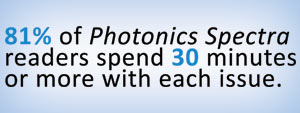 'Dark Marketing' Poses Opportunity, Incites Concern
'Dark Marketing' Poses Opportunity, Incites Concern
Justine Murphy, Senior Editor, [email protected]
It’s easy to stick to traditional outlets and advertising campaigns that for years have produced effective results. The business of marketing and advertising is changing to include new routes that reflect today’s increasingly connected world. Taking the risk of bypassing traditional marketing and advertising can be scary, so it’s important to understand nontraditional approaches.
Dark marketing — also referred to as covert marketing — is evolving, and it’s garnering mixed reviews by marketing professionals.
|
|
|
|
|
|
Upcoming Magazine Features
|
|
| |
|
Trying to get new customers by targeting your product or service to the photonics industry? Take a peek at what our members will be reading about.
APRIL Photonics Spectra
• Lasers in Defense
Contributor: Marie Freebody
Lasers are well-suited for defense applications thanks to their ability to project sufficient energy at long distances from a small package.
 • Drone-based IR Imaging
• Drone-based IR Imaging
Contributor: FLIR Systems
Drones present an interesting combination of benefits, and thermal imaging is the most promising payload for industrial applications.
• Optics in Defense
Contributor: FISBA
As broader imagery access for defense and remote systems continues to advance, product developers and users alike must overcome challenges such as designing and fielding devices that can withstand the environment, producing high-fidelity information and meeting cost targets.
• Laser-Induced Breakdown Spectroscopy
Contributor: Avantes
LIBS had long been considered primarily a research technique, seldom making the jump to industry. In the last decade, however, advances in technology and knowledge are making industrial LIBS applications more commonplace.
• Remote Sensing
Contributor: Hank Hogan
Thanks to advances in photonics and image processing, scientists, farmers, environmentalists, industrialists and those assessing disasters can get a better picture of what's going on. An examination of trends and developments reveals where things are headed and what challenges need to be overcome.
APRIL BioPhotonics
• Live-Cell Imaging
Contributor: Coherent Inc.
Multiphoton microscopy techniques are highly useful for applications such as imaging tissue in live animals, as they cause zero or extremely minimal photo damage. Numerous key trends are emerging across such applications and corresponding advances to support growing market demands.
• Swept-Source OCT
Contributor: Wasatch
Currently, OCT comes in two main technological variations: swept source and spectral domain. Continuous improvements in laser and camera technologies have made the competition between these two modalities more technically interesting and commercially significant.
• Single-Molecule Spectroscopy
Contributor: Marie Freebody
Single-molecule spectroscopy is one of the most powerful techniques to study single entities that ultimately reveal incredibly detailed information about interactions and energy transfer processes between the building blocks of biological cells.
• Biomedical Remote Sensing
Contributor: ContinuUSE Biometrics
There is a focus on remote early detection of diseases obtained by analyzing the spatial-temporal statistics of secondary speckle patterns. These are being back reflected from an inspected relevant tissue, while an external infrasonic pressure, waves-based stimulation is applied.
 APRIL Industrial Photonics
APRIL Industrial Photonics
• 3D Vision for Automation
Contributor: Hank Hogan
With 3D vision, automation systems can better determine the orientation of a part and better measure its dimensions. This makes the act of handling it or performing quality checks easier.
• Machine Vision for Inspection
Contributor: 8tree
With the promise for improved efficiency, machine vision systems are on the rise across all industries, prompting an in-depth focus on design considerations and benefits of vision systems for human operators and their workflows.
• Robot Sensors
Contributor: Optoforce
The sense of touch is in high demand during automation, particularly in the automotive industry where tolerances are often very high. The capability of using the sense of touch expands the options for automation and allows companies to automate monotonous, repetitive work.
• Hyperspectral Imaging
Contributor: Resonon
Hyperspectral imaging can be useful in machine vision, although challenges for the future do exist. Among them is how to obtain commercially viable data.
Contact your Account Manager to reach these customers.
|
|
|
|
Special Marketing Opportunities
|
|
| |
|
Upcoming Webinars: Put your expertise in the spotlight and draw qualified leads with a Photonics Media webinar.
• Selecting the Best Sensor for Your Machine Vision System
Speaker: Tom Brennan, founder and senior engineer of Artemis Vision, and an AIA Advanced Level Certified Vision Professional — April 24
Contact your Account Manager to reach these new buyers.
|
|
|
Visit the Photonics Media booth at upcoming industry events to get the latest issues of our magazines. Are you exhibiting at these events? Make the most of your trade show investment with our preshow marketing opportunities!
PITTCON 2018: Monday, February 26th - Thursday, March 1; booth 2313
Lab Gauntlet Challenge
Test your skills on a variety of fun yet challenging lab activities. There will be two Lab Gauntlet challenge sections at PITTCON 2018: Lab Ninja and Lab X-treme. Prizes will be awarded daily for the best scores; those who run the gauntlet will receive a free T-shirt.
 Photonics Media's challenge will involve our Superresolution Microscopy poster (now available in the Photonics Media Bookstore). Answer the most trivia questions in a minute or less to win! All answers can be found on the poster. And after you've run the gauntlet, stop by our booth 2313 to subscribe — for FREE — to our publications, ask how you can get a free Photonics Media T-shirt, and enter our raffle for a chance to win copies of the Superresolution Microscopy poster and Optical Biomedical Imaging from Photonics Media Press.
Photonics Media's challenge will involve our Superresolution Microscopy poster (now available in the Photonics Media Bookstore). Answer the most trivia questions in a minute or less to win! All answers can be found on the poster. And after you've run the gauntlet, stop by our booth 2313 to subscribe — for FREE — to our publications, ask how you can get a free Photonics Media T-shirt, and enter our raffle for a chance to win copies of the Superresolution Microscopy poster and Optical Biomedical Imaging from Photonics Media Press.
|
|
|
Your monthly marketing and creative tips from our experienced editors and skilled designers.
 Ink Density or the Perils of Reversed Type
Ink Density or the Perils of Reversed Type
Ink Density is the total ink coverage outcome when all of the inks' percentages are added up together in building a CMYK color; this density cannot be more than 300 percent.
Rich blacks are built from more than one color. For example, 100K, 40C will create a cool-toned black. A more neutral, rich black is built using 100K, 40C, 30M and 30Y. When choosing to use a rich black, a bolder font should also be used to avoid registration problems. There will never be registration issues with type that is reversed out of a single color such as 100K.
On average, the presses run from 725 to 1200 feet per minute and produce 23,000 to 43,000 impressions per hour. The vibration alone can create registration problems. The less ink that is used, the better the results will be for reversed-type creation.
Visit Photonics.com/DesignLab to see how we can help you stand head and shoulders above the competition.
|
|
|
 |
|
For more marketing insights, visit the Photonics Media Advertising Hub — your guide to a successful marketing program in the photonics industry. You'll find all the tools you need to build your brand, drive traffic to your website, generate leads and grow sales.
|
|
|